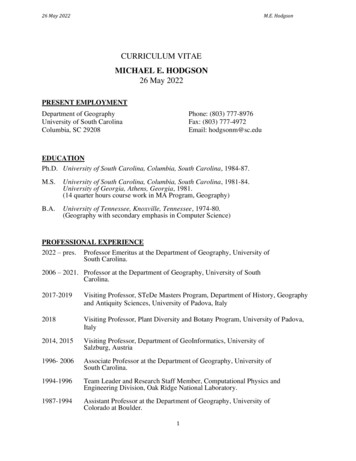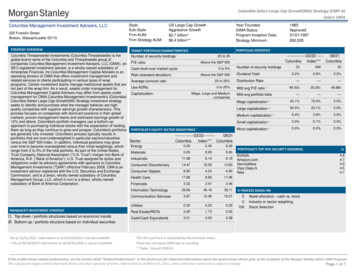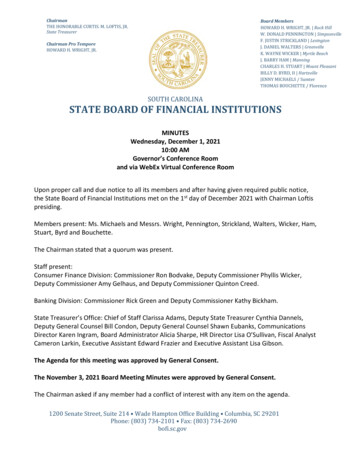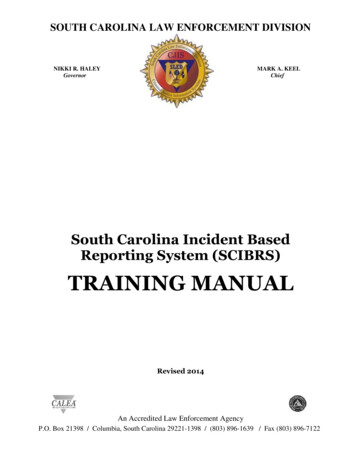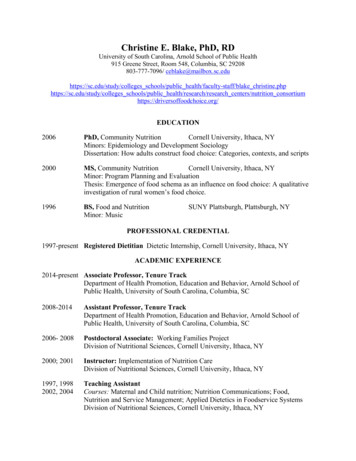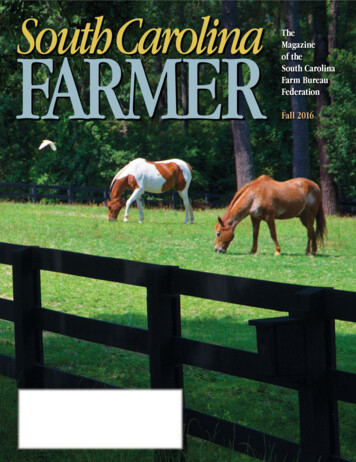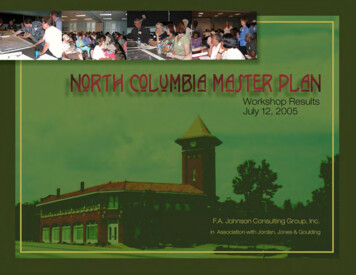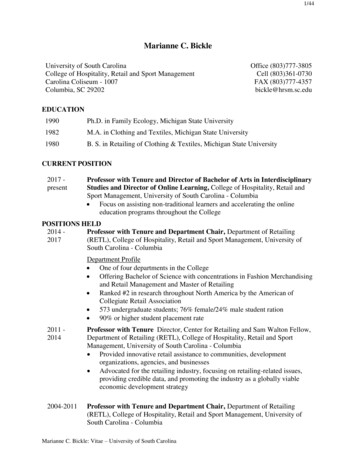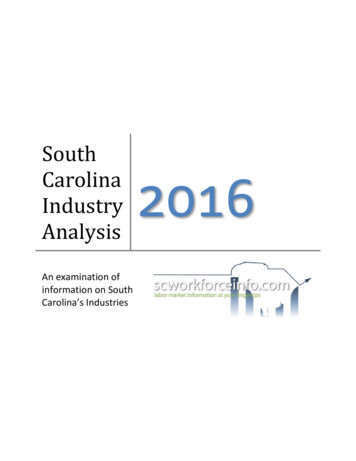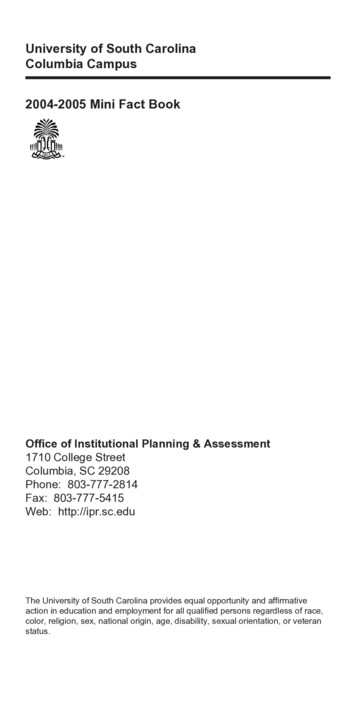
Transcription
University of South CarolinaColumbia Campus2004-2005 Mini Fact BookOffice of Institutional Planning & Assessment1710 College StreetColumbia, SC 29208Phone: 803-777-2814Fax: 803-777-5415Web: http://ipr.sc.eduThe University of South Carolina provides equal opportunity and affirmativeaction in education and employment for all qualified persons regardless of race,color, religion, sex, national origin, age, disability, sexual orientation, or veteranstatus.
About the Cover:Maxcy Monument on the HorseshoeDesigned by Washington Monument architect Robert Mills, the MaxcyMonument honors Jonathan Maxcy, Carolina’s first president from 1804to 1820. The Egyptian Revival-style monument is a hallmark of thetree-shaded Horseshoe, which is the location of the University’s originalcampus and includes many 19th-century buildings.
Table of ContentsHistory of the University of South Carolina.1University of South Carolina Mission Statement.3USC Columbia Mission Statement.5Accreditations.7Board of Trustees.9Administrative Officers.9University Libraries.10Statistical Summary for Columbia (Fall 2004).12Fall Enrollment (School) 2000-2004.14Spring Enrollment (School) 2000-2004.15Summer Enrollment (School) 2004.16Enrollment (School) by Race—Fall 2004.17Enrollment (School) by Gender—Fall 2004.18Enrollment (School) by Full-Time/Part-Time—Fall 2004.19Enrollment (School) by Classification—Fall 2004.20Fall FTE by College (2000-2004).21Fall FTE Percentage Distribution by College (2000-2004).22New Freshmen Profile—Fall 2004.23New Freshmen and New Transfer Applications (1991-2004).24Return Rate (%) as of Fall 2004.25Graduation Rate (%) as of Fall 2004.25Student Financial Aid & Scholarships (FY 2003-2004).26Degrees Offered.27Degrees Awarded Profile (FY 2003-2004).30Degrees Awarded by Schools and Colleges (2000-2004).31Sponsored Awards Management—By Purpose (FY 2003-2004).33Sponsored Awards Management—By Source (FY 2003-2004).34Current Funds Revenues and Expenses (FY 2003-2004).35Average Full-Time Teaching Faculty Salaries (1990-2004).36Distribution of Tenured/Tenure-Track Faculty—Fall 2004.37
History of theUniversity of South CarolinaChartered in 1801 as South Carolina College, the Universityof South Carolina was the first state university to be supportedcontinuously by annual state appropriations. In the years beforethe Civil War, it rapidly achieved a reputation for academicexcellence in the classical tradition and was known as oneof the best endowed and most distinguished colleges in theUnited States. Its faculty included Francis Lieber, editor of theEncyclopaedia Americana and author of On Civil Liberty andSelf-Government; the nationally known scientists John andJoseph LeConte; and chemist William Ellet, who producedsome of the first daguerreotypes in the United States. By the1830s, distinguished alumni virtually filled the state’s GeneralAssembly. James H. Hammond and Wade Hampton were themost prominent of a parade of future governors, senators,judges, and generals who graduated during the antebellumperiod.The pre-Civil War campus included Longstreet Theatreand all the buildings in the area known today as the Horseshoe(with the exception of McKissick Museum). When the voluntaryenlistment of all students into the Army of the Confederacyforced the college to close in June 1862, the buildings wereused by the Confederate government as a hospital. By thetime General Sherman’s army reached Columbia in February1865, the hospital housed wounded Union soldiers as well. Afire soon started that destroyed most of the city, but federaltroops helped save the campus buildings from the flames.After reopening in 1865, the institution went through sixreorganizations and name changes during the last decades ofthe 19th century, while legislators, administrators, and facultiesreassessed the institution’s goals and struggled to define itsmission. Finally in 1906, at the beginning of its second century,it was rechartered for the third, and last, time as the Universityof South Carolina, with a graduate school.In sharp contrast to the South Carolina College’santebellum, elitist philosophy, President William Davis Meltonin 1925 expressed a far-reaching principle that had emergedin the first quarter of the century: “Education is not a specialprivilege to be enjoyed by a special few.” Thus, in its final1
reorganization, the University of South Carolina developed thisinstitutional objective: to furnish both liberal and professionaleducation to the people of South Carolina.Efforts to achieve this objective were almost immediatelyhampered by the early arrival of the Great Depression in SouthCarolina. Enrollment declined, some courses were eliminated,and buildings went without repairs. The situation improvedgreatly in the late 1930s because of grants from federal NewDeal agencies. Then America entered World War II, and thecampus was virtually transformed into a naval training base,with payments from the Navy helping the school continue tofunction during the war years.Fulfillment of the promise of the early years of the 20thcentury began in earnest in the 1950s. Since then, dynamicacademic expansion and the development of a statewidenetwork of campuses have produced highly diverse andinnovative education programs. A commitment to graduateeducation along with involvement in major research programshas attracted an outstanding faculty.In keeping with both its 19th-century and its 20th-centuryheritage, the University continues to promote academicexcellence while responding progressively to its educationalresponsibilities and the citizens of South Carolina. It hascommitted itself to earning a place in the Association ofAmerican Universities (AAU), which includes 60 of the finestinstitutions of higher learning in America. Pursuing this goal, theUniversity aspires to build upon its commitment to enhancingnot only our students’ knowledge, understanding, and economicviability, but also their sense of character, empathy, and mutualrespect. Such ambitions and ideals were cornerstones of theoriginal college and remain fundamental to the University’spurpose in South Carolina and in society.2
University of South CarolinaMission StatementThe primary mission of the University of South Carolina, amulti-campus public institution serving the entire state of SouthCarolina, is the education of the state’s diverse citizens throughteaching, research and creative activity, and service.TeachingThe University is committed to providing its students with thehighest-quality education, including the knowledge, skills, andvalues necessary for success and responsible citizenship ina complex and changing world. A particular strength of theUniversity of South Carolina is the excellence, breadth, anddiversity of the institution’s faculty.ResearchConvinced that research and scholarship, including artisticcreation, are essential for excellent teaching, the Universitypursues aggressively an active research and scholarshipprogram. The University is dedicated to using research toimprove the quality of life for South Carolinians.ServiceAnother important facet of the University’s public missionis service—to its community, state, nation, and the world insuch areas as public health, education, social issues, economicdevelopment, and family support systems.Founded in 1801 in Columbia, the University of SouthCarolina began providing programs in communities statewidein the 1950s and 1960s. At that time, a network of campuseswas established in response to community initiative and supportfor accessible, affordable educational programs principally forlocal citizens. In the 1970s, the Aiken and Spartanburg (nowUSC Upstate) senior campuses were granted the authorityto award baccalaureate degrees. The Beaufort campus wasgiven this same authority in 2002. While the regional campuses,the senior campuses, and the Columbia campus all pursueteaching, research, creative activity, and service, each does sowith an emphasis suited to its individual campus mission.3
Flagship Campus in ColumbiaAs a major teaching and research institution, USC, located inthe state capital in Columbia, has long offered a comprehensiverange of undergraduate and graduate programs through thedoctoral level. With a mission of teaching, research, andservice, USC addresses the state’s needs for master’slevel, professional, and doctoral education, for conductingand sharing research, and for responding to statewide andregional demands for educational resources and professionalexpertise.The University of South Carolina aspires to national andinternational stature as it provides equitable access to itsopportunities, resources, and activities.Senior CampusesSeparately accredited by the Southern Association of Collegesand Schools (SACS), Aiken, Beaufort, and Upstate take as theirprimary mission the delivery of basic undergraduate educationto their respective areas. These senior campuses also offergraduate-level coursework through the University’s ExtendedGraduate Campus program, and sometimes offer master’sdegree programs in response to regional demand.Regional CampusesAccredited with USC Columbia by the Southern Associationof Colleges and Schools, the regional campuses in Lancaster,Allendale (Salkehatchie), Sumter, and Union principallyprovide the first two years of undergraduate education,as well as selected associate degree programs mainly fortheir locales. The regional campuses also provide for thecompletion of bachelor degrees by offering selected upperdivision course work in conjunction with the Aiken, Beaufort,Columbia, and Upstate campuses, as well as some graduateeducation through the University’s Extended Graduate Campusprogram. In addition to providing these programs, the regionalcampuses bring the resources of the entire University to citizensthroughout the state.Approved by the Board of Trustees (June 30, 2004)Source: http://president.sc.edu/mission.html (November 29, 2004)4
USC ColumbiaMission Statement*Committed to becoming one of the finest universities in America,USC Columbia is dedicated to nationally recognized excellencein its student population, faculty, academic programs, livingand learning environment, technological infrastructure, libraryresources, research and scholarship, public and privatesupport, and endowment. The University is further resolved toenhance the industrial, economic, and cultural potential of thestate so that South Carolina and the University can prospertogether. USC Columbia recognizes its historic responsibilityto achieve overall excellence and to provide South Carolina’scitizens a university as good as any in the nation.One of the oldest and most comprehensive publicuniversities in the United States, the University of SouthCarolina Columbia is the major research center of the Universityand its largest campus, enrolling some 17,000 undergraduatestudents and over 6,500 students in graduate and professionalprograms. From its location in the state capital, the Universityoffers a range of excellent programs and activities designedto enhance the intellectual, cultural, physical, and socialdevelopment of its diverse student body. Students can pursuebachelor’s, master’s, doctoral, and professional degrees inapproximately 300 major degree programs. USC Columbia’sprofessional programs in law, pharmacy and medicine, and themagnitude of its graduate programs in areas such as the artsand sciences, international business, public health, social work,and library and information science distinguish it from all otherinstitutions of higher learning in the state of South Carolina.Additional opportunities for personal and career development,including an associate degree program at Fort Jackson, areprovided to the citizens of South Carolina through outreach andcontinuing education activities. USC Columbia offers the mostcomprehensive array of educational programs in the state, andis the only South Carolina institution classified as a Four YearI by the Southern Regional Education Board.Students at USC Columbia come from variousbackgrounds, with different career goals and levels ofaspiration. The distinctiveness of USC Columbia lies in theconspicuous diversity that nurtures and stimulates students,faculty, and constituents. USC Columbia aspires to national5
and international stature as it provides equitable access to thefull range of its opportunities, resources, and activities.As a relatively selective institution, USC Columbia seeksto attract inquisitive students who have demonstrated academicability, who are committed to learning, who are capable ofself-discipline, and who wish to benefit from the variety ofexperiences provided by a major university with students,faculty, and staff drawn from throughout South Carolina,the nation, and the world. The University strives to educategraduates who are capable of excelling in their chosen fields,who are dedicated to learning throughout their lives, andwho are responsible citizens in a complex society requiringdifficult ethical and value-related decisions. By offering itsstudents reasonable freedom to select from among the manyexperiences available in liberal arts, the natural sciences, thesocial sciences, the performing and creative arts, and theprofessions, USC Columbia encourages students to seektheir full potential in the broad array of endeavors associatedwith our various schools and colleges.A central mission to the University is to advance knowledgeand enrich our cultural heritage. To achieve this mission, theUniversity supports a faculty actively engaged in research ina breadth of disciplines including those listed above.An important mission of the University is to engage theconsiderable resources of the institution in service to thestate and society for the purposes of cultural enrichment,the dissemination of knowledge, and the enhancement of theoverall quality of life. USC Columbia’s teaching, research, andservice programs affect every part of life in South Carolina.* Approved by the Board of Trustees—April 23, 1998 (with annual statisticalupdates)6
Accreditations of Academic ProgramsThe Moore School of BusinessAmerican Assembly of Collegiate Schools of BusinessSchool of LawAmerican Bar AssociationAssociation of American Law SchoolsSchool of MedicineLiaison Committee on Medical Education of the American MedicalAssociationAssociation of American Medical CollegesSchool of MusicNational Association of Schools of MusicThe Arnold School of Public HealthAmerican Boards of Examiners in Speech Pathology and Audiologyof the American Speech and Hearing AssociationCouncil on Education for Public HealthNational Council for Accreditation of Teacher EducationNational Association of State Directors of Teacher Education andCertificationCollege of EducationCouncil for the Accreditation of Counseling and Other RelatedEducational Programs.National Council for Accreditation of Teacher EducationCollege of Engineering and Information TechnologyComputing Accreditation Commission of the Accreditation Board forEngineering and TechnologyEngineering Accreditation Commission of the Accreditation Board forEngineering and TechnologyCollege of Hospitality, Retail, and Sport ManagementAccreditation Commission for Programs in Hospitality AdministrationCollege of Liberal ArtsAmerican Psychological AssociationNational Association of State Directors of Teacher Education andCertificationNational Council for Accreditation of Teacher EducationNational Association of School PsychologistsNational Association of Schools of Public Affairs and AdministrationNational Association of Schools of Theatre University/ResidentTheatre AssociationNational Association of Schools of Art and Design7
College of Mass Communications and Information StudiesAccrediting Council on Education in Journalism and MassCommunicationsAmerican Library AssociationCollege of NursingCommission on Collegiate Nursing EducationCollege of PharmacyAmerican Council on Pharmaceutical EducationCollege of Science and MathematicsAmerican Chemical SocietyCollege of Social WorkCouncil on Social Work EducationSource: 2004/2005 USC Bulletin as of 11/29/048http://www.sc.edu/bulletin
Board of TrusteesGovernor of South CarolinaState Superintendent of EducationPresident, USC Alumni AssociationGubernatorial AppointeeGubernatorial Appointee1st Judicial Circuit2nd Judicial Circuit3rd Judicial Circuit4th Judicial Circuit5th Judicial Circuit6th Judicial Circuit7th Judicial Circuit8th Judicial Circuit9th Judicial Circuit10th Judicial Circuit11th Judicial Circuit12th Judicial Circuit13th Judicial Circuit14th Judicial Circuit15th Judicial Circuit16th Judicial CircuitSecretaryMark SanfordInez TenenbaumRita M. McKinneyDarla D. MooreMark W. Buyck, Jr.Othniel H. Wienges, Jr.Miles LoadholtArthur S. BahnmullerEugene P. Warr, Jr.William C. HubbardJames BradleyToney J. ListerHerbert C. AdamsJohn C. von Lehe, Jr.Robert N. McLellanMichael J. MungoC. Edward Floyd, M.D.Mack I. Whittle, Jr.William Wes JonesM. Wayne StatonSamuel R. Foster, IIThomas L. SteppAdministrative OfficersPresidentExecutive VP for Academic Affairs and ProvostVice President and Chief Financial OfficerSecretary of the Board of Trusteesand University Secretary and TreasurerVice President for Human ResourcesVice President for Medical Affairs and DeanVice President for Student Affairs and Dean of StudentsGeneral CounselVice President of Research and Health SciencesVP for Information Technology and CIOVice Provost and Executive DeanVice President for University AdvancementChancellor, USC AikenChancellor, USC BeaufortChancellor, USC UpstateDean, USC LancasterDean, USC SalkehatchieDean, USC SumterDean, USC Union9Andrew A. SorensenMark P. BeckerRichard W. KellyThomas L. SteppJane M. JamesonLarry R. FaulknerDennis A. PruittWalter H. ParhamHarris PastidesWilliam F. HogueChris P. PlylerHudson AkinThomas L. HallmanJane UpshawJohn C. StockwellJohn CatalanoAnn C. CarmichaelC. Leslie CarpenterJames W. Edwards
University LibrariesThe library resources of the University of South Carolina are housed primarily in theThomas Cooper Library, the Coleman Karesh Law Library of the School of Law, andthe School of Medicine Library. The University of South Carolina holds membershipin the Association of Research Libraries.University LibrariesThe components of the University Libraries which are located on the Columbiacampus are Thomas Cooper Library, Business Administration Library, MathematicsLibrary, Music Library, and South Caroliniana Library.The Thomas Cooper Library is a seven story structure near the geographiccenter of campus. The Library seats 2,400 people, contains over 3,000,000 volumes,4,000,000 microfilms, 1,000,000 manuscripts, 300,000 maps, 800,000 governmentdocuments and houses the University's special collections. The Library contains aStudent Computer Lab, with over 200 IBM and Macintosh networked workstations,900 locked faculty and graduate student study carrels, and 40 group study rooms.The staff of the Thomas Cooper Library and its affiliated libraries is composedof 164 full-time and 4 part-time employees and supplemented by approximately 100student assistants. Sixty-two of the full-time staff are librarians holding faculty positionswith appropriate degrees in library science from accredited library schools.University Libraries hold membership in the Southeastern Library Network,which provides online automated cataloging services and interlibrary lending. Otherautomated services include an online catalog (NOTIS), online circulation system(NOTIS), online acquisitions system (NOTIS), a CD-ROM network, and onlinereference service from a variety of vendors. The online catalog is available fromoff-campus locations.Coleman Karesh Law LibraryThe Coleman Karesh Law Library, the largest law library in the state of South Carolina,is located in the Law Center. The Law Library is an integral part of the School of Law,reporting administratively to the Dean of the Law School. In addition to supporting theresearch and study of the University's law students and law faculty, the Law Libraryserves the legal research needs of other University students and faculty and thestate's legal community and public.The four-story facility houses a collection of over 300,000 volumes. The focusof the collection is primary and secondary American Law materials, but includes agrowing collection of international law materials. The Law Library provides seatingfor over 600 researchers, including carrels, study rooms, and open table seating.The Law Library staff consists of 15 full-time employees and 5 FTE of temporaryand student employees. The seven librarians of the Law Library staff hold graduatedegrees in library science. Four of the librarians also have legal training. Thelibrarians, with the exception of the Director of the Law Library, are members of theLaw Library Faculty. The Director of the Law Library is a member of the Law SchoolFaculty.The Law Library holds membership in the Southeastern Library Network forcataloging and interlibrary loan. The Law Library also participates in the University'sautomated NOTIS system, utilizing the online catalog, acquisitions, and circulationmodules.10
School of Medicine LibraryThe School of Medicine Library is located approximately four miles from the maincampus. It is an integral part of the School of Medicine, which is adjacent to the Veteran’sAdministration Hospital on Garners Ferry Road. In addition to serving the School ofMedicine, the Medical Library is an information resource for health care practitionersthroughout the state.The School of Medicine Library contains over 95,000 volumes of highly specializedmaterial relating to medicine and subscribes to over 1,200 periodicals.The Library staff is composed of 17 full-time employees, seven of whom are librarianswho hold faculty positions and possess appropriate graduate degrees in library science.The Medical Library Faculty are tenure-track members of the School of MedicineFaculty.The School of Medicine Library holds membership in the Southeastern Library Networkfor cataloging and interlibrary loan. The Medical Library participates in the University'sautomated NOTIS system.Combined holdings for the University Libraries, the Coleman Karesh LawLibrary, and the School of Medicine 33 3,283,749 3,333,764 3,374,496 3,436,445Microforms4,866,878 4,939,906 5,008,383 5,060,469 5,108,721Periodical Titles20,46821,42621,83622,74424,152US 2,352312,502312,950313,400315,585Graphic Units250,000250,000250,000250,000250,000Audio Units32,89533,37833,95334,31535,149Film/Video Units11,19411,57911,97712,33313,913Cartographic n917,700916,149923,940977,988 063Interlibrary LoanReference Questions11
Statistical Summary - Fall 2004School Name:University of South CarolinaMinority:Undergraduate: 3,656 (20.67%)Graduate: 1,879 (28.86%)Professional: 193 (13.82%)Address:Columbia, SC 29208African American:Undergraduate: 2,592 (14.65%)Graduate: 901 (13.83%)Professional: 97 (6.95%)Admissions:Undergraduate:Lieber College803-777-7700800-868-5872Residency (Fee-based):Out-of-State: 12%In-State: 88%Graduate:Byrnes Building803-777-4243New Freshmen:Applicants: 12,379Accepted: 8,344Enrolled: 3,403Location:Urban CampusTransfer:Applicants: 3,409Accepted: 1,879Enrolled: 1,196City e: 17,689Masters: 4,836Doctorate: 1,675Professional: 1,396Deadlines: (Priority)Admissions: NoneFinancial Aid: April 15Retention:84.9% of Freshmen continue63.6% graduate after 6 yearsMale/Female:Undergraduate:8,077 / 9,612(45% / 55%)Graduate:2,375 / 4,136(36% / 64%)Professional:648 / 748(46% / 54%)University Support:Current Endowment: 329.8mTotal Private Support: 64.7mNumber of Donors: 39,407Alumni Donors: 22,319Living Alumni: 210,000 Alumni AssociationMembership: 30,200 12
Statistical Summary - Fall 2004 (cont.)Schools/Colleges: 17Housing:42% of undergraduates live on campusMajors:29 Residence hallsTypes: Coed, Apartments, Married,Greek, Honors, Pre-Medical,Engineering Community, TeachingFellows, US/International, Wellness,Athletic, Residential :58Professional:3Tuition & Fees:Degrees Awarded: FY 2003-04Academic Year (Undergraduate)AfricanTotal American 6,386 In-State (approx.) 16,754 Out-of-State (approx.)AssociatesRoom & Board:Academic Year 5,590 ,721Periodicals:24,152Computers:200 330-800 (Avg.:569)Math:330-800 ofessional38026*includes Certificates and SpecialistsFaculty:Full-Time: 1500Part-Time: 486SAT Score Range of New Freshmen:Verbal:12BachelorsStaff*: 2728*excludes student employeesFaculty Degrees: (Ranked te Greek population: 17%Ph.D.84.6%M.D.0.4%LLM1.2%JD or LLBTop 3 Undergraduate Majors byDegrees Awarded:MastersBachelorsExperimental PsychologyFinance2.3%11.2%0.4%Financial Aid:MarketingUndergrad. Students Receiving Aid89% of New Freshmen80% of Continuing Students13
Fall Enrollment (School)2000-20042000UNDERGRADUATEUndergraduate StudiesNursingPharmacyArnold School of Public HealthContinuing EducationCont. Educ. HS/DistScience & MathHosp, Retail & Sport Mgmt.Liberal Arts*South Carolina CollegeMusicMoore School of BusinessEducationEngineering & Info. TechnologyMass Comm. & Info. Studies**Fort JacksonUndergraduate 1,651 1,605 1,701 1,757 1,7951,342 1,584 1,563 1,433 1,5594,433 4,583 5,091 5,303 5,36613910853293183133243362,685 2,607 2,636 2,719 2,8491181031232585911,532 1,467 1,457 1,421 1,3741,089 1,223 1,424 1,522 1,5031351791211158615,266 15,506 16,567 17,133 17,689GRADUATEMedicineNursingPharmacySocial WorkArnold School of Public HealthSchool of the EnvironmentGraduate - Non-DegreeScience & MathHosp, Retail & Sport Mgmt.Liberal Arts*MusicMoore School of BusinessEducationEngineering & Info. TechnologyMass Comm. & Info. Studies**Interdisc Studies (MAT/IMA)Engineering & Info. Tech. - APOGEEM.B.A.- E.T.V.Graduate edicine - MDPharmacyLaw SchoolProfessional 2617401,2983063347561,396COLUMBIA TOTAL23,728 23,000 25,140 25,288 25,596*Includes Criminal Justice**Includes Journalism and Library & Info. Studies14
Spring Enrollment (School)2000-2004UNDERGRADUATEUndergraduate StudiesNursingPharmacyArnold School of Public HealthContinuing EducationCont. Educ. HS/DistScience & MathHosp, Retail & Sport Mgmt.Liberal Arts*South Carolina CollegeMusicMoore School of BusinessEducationEngineering & Info TechnologyMass Comm. & Info Studies**Fort JacksonUndergraduate 122,075 1,502 1,465 1,561 1,6411,168 1,322 1,540 1,455 1,4574,209 4,272 4,434 4,921 5,1221513121093092992892792942,597 2,430 2,379 2,463 2,537114103102116332948136612931331 1,280961104912081342 1,40815815214211612113,988 13,891 14,271 14,279 15,959GRADUATEMedicineNursingPharmacySocial WorkArnold
University of South Carolina Chartered in 1801 as South Carolina College, the University of South Carolina was the first state university to be supported continuously by annual state appropriations. In the years before the Civil War, it rapidly achieved a reputation for academic excellence in the classical tradition and was known as one
